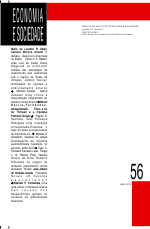Resumo
Este artigo utiliza um referencial teórico schumpeteriano e kaleckiano para apresentar um modelo setorial capaz de captar os efeitos dinâmicos das inovações sobre a competitividade e a distribuição setorial funcional da renda. Adota-se a teoria distributiva de Kalecki, segundo a qual a distribuição funcional da renda é vinculada ao processo de formação de preços por mark-up. É desenvolvido um modelo de simulação para as interações entre firmas dentro de setores específicos a partir do método Agent-based modelling. A principal conclusão é que os resultados obtidos pelas simulações mostram que as inovações tecnológicas, ao influenciarem preço e mark-up, afetam diretamente a distribuição.Referências
AFUAH, A. N.; UTTERBACK J. M. Responding to structural industry changes: a technological evolution perspective. Industrial and Corporate Change, v. 6, p. 183-202, 1997.
ARTHUR, W. B. Out-of-equilibrium economics and agent-based modeling. In: JUDD, K.; TESFATSION, L. (Ed.). Handbook of computational economics. v. 2: Agent-based computational economics. Amsterdam: Elsevier/North-Holland, 2005.
AXELROD, R. Advancing the art of simulation in the social sciences. In: RENNARD, J. P. (Ed.). Handbook of research on nature inspired computing for economy and management. Hershey: Idea Group, 2005.
CYERT, R. M.; MARCH, J. G. A behavioral theory of the firm. New Jersey: Englewood Cliffs, 1963.
CORSINO, M.; GABRIELE, R. Product innovation and firm growth: evidence from the integrated circuit industry. Industrial and Corporate Change, v. 20, p. 29-56, 2010.
DAWID, H. Agent-based models of innovation and technological change. In: JUDD, K.; TESFATSION, L. (Ed.). Handbook of computational economics. v. 2: Agent-based computational economics. Amsterdam: Elsevier/North-Holland, 2005.
DANEELS, E. The dynamics of product innovation and firm competences. Strategic Management Journal, 23, p. 1095-1121, 2002.
DAMANPOUR, F.; GOPALAKRISHNAN, S. The dynamics of the adoption of product and process innovation in organizations. Journal of Management Studies, 38, p. 45-65, 2001.
DOSI, G. Sources, procedures, and microeconomic effects of innovation. Journal of Economic Literature, 26, p. 1120-1171, 1988.
DOSI, G.; PAVITT K.; SOETE, L. The economics of technical change and international trade. New York: New York University Press, 1990.
DOSI, G.; MALERBA, F.; MARSILI, O.; ORSENIGO, L. Industrial structures and dynamics: evidence, interpretations and puzzles. Industrial and Corporate Change, 6, p. 5-24, 1996.
DOUGHERTY, D. Interpretive barriers to successful product innovation in large firms. Organization Science, 3, p. 179-202, 1992.
DWECK, E. Uma análise da interação micro-macro com base em um modelo dinâmico multissetorial de simulação. 2006. Tese (Doutorado)–Instituto de Economia (IE), UFRJ, Rio de Janeiro, 2006.
EISENHARDT, K. M.; TABRIZI, B. N. Accelerating adaptative process: product innovation in the global computer industry. Administrative Science Quartely, 40, p. 84-110, 1995.
GARSON, G. D. Computerized simulation in the social sciences: a survey and evaluation. Simulation and Gaming, 4, p. 267-279, 2009.
KALECKI, M. Theory of economic dynamics. 2 nd ed. London: Allen & Unwin, 1954.
MALERBA, F. Learning by firms and incremental technical change. The Economic Journal, 102, p. 845-859, 1992.
NELSON, R.; WINTER S. An evolutionary theory of economic change. Cambridge: Harvard University, 1982.
NONAKA, I. A dynamic theory of organization knowledge creation. Organization Science, 5, p. 14-37, 1994.
PLEATSIKAS, C.; TEECE D. The analysis of market definition and market power in the context of rapid innovation. International Journal of Industrial Organization, 19, p. 665-693, 2001.
POSSAS, M. L. Dinâmica e ciclo econômico em oligopólio. 1983. Tese (Doutorado)–Instituto de Economia (IE), Unicamp, Campinas, 1983.
POSSAS, M. L.; KOBLITZ, A.; LICHA, A.; OREIRO, J. L.; DWECK, E. Um modelo evolucionário setorial. Revista Brasileira de Economia, 55, p. 333-377, 2001.
SAVIOTTI, P. P. Variety, growth and demand. Journal of Evolutionary Economics, 11, p. 119-142, 2001.
SAVIOTTI, P. P.; PYKA, A. Micro and macro dynamics: industry life cycles, inter-sector coordination and aggregate growth. Journal of Evolutionary Economics, 18, p. 167-182, 2008.
SILVERBERG, G. Technical progress, capital accumulation and effective demand: a self-organization model. In: BATTEN, D.; CASTI, J.; JOHANSSON, B. (Ed.). Economic evolution and structural adjustment. Berlin: Springer-Verlag, 1987.
SILVERBERG, G.; DOSI, G.; ORSENIGO, L. Innovation, diversity and diffusion: a self-organization model. The Economic Journal, 38, p. 1032-1054, 1988.
STORPER, M. Innovation as collective action: conventions, products and technologies. Industrial and Corporate Change, 5, p. 761-790, 1996.
SCHUMPETER, J. Capitalism, socialism and democracy. London: George Allen & Unwin, 1943.
UTTERBACK, J. M. Mastering the dynamics of innovation. Boston: Harvard Business School Press, 1994.
VALENTE, M. Evolutionary economics and computer simulation: a model for the evolution of markets. 1999. PhD in Economics – University of Aalborg, Aalborg, 1999.
VERONA, G.; RAVASI, D. Unbundling dynamic capabilities: an exploratory study of continuous product innovation. Industrial and Corporate Change, 12, p. 557-606, 2003.
A Economia e Sociedade utiliza a licença do Creative Commons (CC), preservando assim, a integridade dos artigos em ambiente de acesso aberto.

